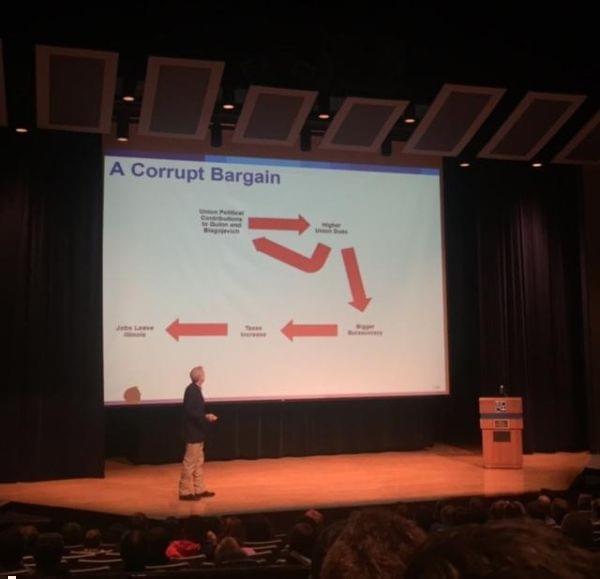The Players: No Joke - Business, Labor And Rauner Have Reached A Deal. Here’s How.

Gov. Bruce Rauner's saying that public sector unions have a "corrupt bargain" with some politicians contributed to a divide between the Republican's administration and labor; but they've gotten past that when it comes to unemployment insurance concerns. Amanda Vinicky/WUIS
Here's a phrase I bet you didn't expect to hear, given Republicans and business/versus Democrats and unions battling in Illinois these days: "This is an agreement that was reached between the department, organized labor and business."
But when Illinois State Rep. Jay Hoffman, D-Swansea, said that on the House floor Wednesday, he wasn't kidding. Gov. Bruce Rauner's administration, labor, and business, all agreed on something: changes to the unemployment insurance program.
It's a big deal, for workers who get laid off. It's a big expense for businesses. Plus, given the political climate in Springfield, any compromise is worthy of attention.
The deal makes a couple of major changes to Illinois' unemployment insurance program. For one, it does away with something called the "Social Security Offset."
"For working people the one item that was gained in these negotiations -- it's primarily for older workers who are receiving Social Security. Currently they receive their unemployment benefits reduced by the amount of money that they receive from the federal government in Social Security benefit," explains Sean Stott, the government relations director for the Laborers' International Union - Midwest Region.
Under the new terms, that's gone: Older workers who've been laid off will no longer get a smaller unemployment benefit just because they're on social security.
Paying out more benefits, though, will cost employers more -- they think to the tune of $25 million. So the deal also does something that makes the business side happy, something employers hope will lower their expenses.
"We have redefined misconduct," Rob Karr, head of the Illinois Retail Merchants Association, says. "So employees who do certain things under misconduct, they will be less able to obtain their benefits if they did something wrong in the workplace, like ignored employer policies on attendance or used illegal substances on the job. Those type of things would more likely get them disqualified from unemployment benefits. Which means - we think - that's enough to offset the increase in the unemployment insurance taxes."
So how did these two competing interests come to an agreement? In a sense, their hands were forced, because the current law governing unemployment insurance set up an end-of-year deadline.
"Every time we do an agreed bill process, and we've done a number of these over the course of decade (all successfully), we intentionally insert what are called 'rest stops' or 'speed bumps' " Karr explains. "They force both sides back to the table, if nothing else to review the program, see how it's working, each side then has the opportunity to ask for additional tweaks to the program."
Basically, workers would have gotten less, businesses would have had to pay more.
"Employer unemployment taxes would have gone up, workers who were unemployed would have seen their benefits reduced. And neither side, of course, wanted to see that happen. And as a result that brought both parties back together," Stott says.
You could say it's a game of political chicken, that worked.
Legislators like Rep. David Harris, R-Arlington Heights, say this should be the path for future deals.
"Let us use that as an example of what we can do on the budget and on other issues that are tying us up in other areas," he said during debate.
That could be easier said than done.
Stott says this is different than, say, Gov. Rauner's calls for limiting collective bargaining.
"If both sides are reasonable in what their requests are, there may be some, ability to work together to get a compromise," he said. "Unfortunately a lot of the things that we have seen come out of the governor's office are not reasonable, when it comes to taking away collective bargaining rights for workers in local governments, when it comes to cutting wages for construction workers on local construction projects, there's nothing there that labor can see as a path to coming to a resolution on."
Even so, IRMA's Karr says there's reason to find hope in how the unemployment insurance deal came about.
"I think the fact that the speed bumps force you back to the table is an inherent encouragement, right, for both sides," Karr said. "But both sides could have ignored it. The governor's office could not have convened it, they chose to convened the agreed-bill processes, they chose to oversee it and they did so in a very mild-mannered approach. And I think that does show an example of what can happen when all sides choose to make it happen."
The next speed bump hits in 2018, so these players will be back at the negotiating table in 2017.
Links
- Illinois Unemployment Falls Again, To 6.6 Percent
- Unemployment Falls To 5.9 Percent, Lowest In 6 Years
- Quinn: Illinois’ Unemployment Drop Is `Momentous’
- Unemployment Ticks Up To 6.2 Percent; 209,000 Jobs Added
- Pending Supreme Court Decision Creates Health Insurance Uncertainty
- Health Insurance Costs Up In Parts Of Illinois
